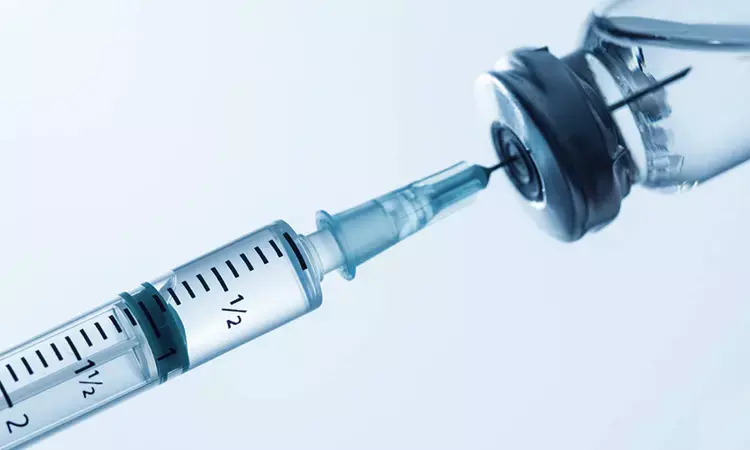- Home
- Medical news & Guidelines
- Anesthesiology
- Cardiology and CTVS
- Critical Care
- Dentistry
- Dermatology
- Diabetes and Endocrinology
- ENT
- Gastroenterology
- Medicine
- Nephrology
- Neurology
- Obstretics-Gynaecology
- Oncology
- Ophthalmology
- Orthopaedics
- Pediatrics-Neonatology
- Psychiatry
- Pulmonology
- Radiology
- Surgery
- Urology
- Laboratory Medicine
- Diet
- Nursing
- Paramedical
- Physiotherapy
- Health news
- Fact Check
- Bone Health Fact Check
- Brain Health Fact Check
- Cancer Related Fact Check
- Child Care Fact Check
- Dental and oral health fact check
- Diabetes and metabolic health fact check
- Diet and Nutrition Fact Check
- Eye and ENT Care Fact Check
- Fitness fact check
- Gut health fact check
- Heart health fact check
- Kidney health fact check
- Medical education fact check
- Men's health fact check
- Respiratory fact check
- Skin and hair care fact check
- Vaccine and Immunization fact check
- Women's health fact check
- AYUSH
- State News
- Andaman and Nicobar Islands
- Andhra Pradesh
- Arunachal Pradesh
- Assam
- Bihar
- Chandigarh
- Chattisgarh
- Dadra and Nagar Haveli
- Daman and Diu
- Delhi
- Goa
- Gujarat
- Haryana
- Himachal Pradesh
- Jammu & Kashmir
- Jharkhand
- Karnataka
- Kerala
- Ladakh
- Lakshadweep
- Madhya Pradesh
- Maharashtra
- Manipur
- Meghalaya
- Mizoram
- Nagaland
- Odisha
- Puducherry
- Punjab
- Rajasthan
- Sikkim
- Tamil Nadu
- Telangana
- Tripura
- Uttar Pradesh
- Uttrakhand
- West Bengal
- Medical Education
- Industry
Novel Cholesterol Drug Vupanorsen Shows Promising Effect But With Notable Safety Concerns

Genetic loss-of-function variants in Angiopoietin-like 3 (ANGPTL3) are associated with lower levels of plasma lipids. A recent study suggests that high dose ANGPTL3 inhibitors reduce non-high-density lipoprotein cholesterol (non-HDL-C) and triglycerides however accompanied by few safety concerns. The study findings were published in the journal Circulation on April 03, 2022.
Vupanorsen is an N-acetyl galactosamine–conjugated antisense oligonucleotide targeting ANGPTL3 mRNA in the liver. A phase 2a trial of vupanorsen in patients with hypertriglyceridemia, hepatic steatosis, and type 2 diabetes showed significant reductions in triglycerides at all doses studied, as well as reductions in non–high-density lipoprotein cholesterol (non-HDL-C) at the highest doses. Therefore Dr Brian A. Bergmark and hi steam conducted a phase 2b dose-escalation TRANSLATE (Targeting ANGPTL3 with an Antisense Oligonucleotide in Adults with Dyslipidemia)–TIMI (Thrombolysis in Myocardial Infarction) 70 trial.
In TRANSLATE-TIMI 70 trial the researchers assessed the effect of escalating doses of vupanorsen on non–HDL-C levels in statin-treated adults with hyperlipidemia. They included 286 patients with non-high-density lipoprotein cholesterol (non-HDL-C) ≥100 mg/dL and triglycerides 150 to 500 mg/dL on statin therapy. The researchers further randomized them to placebo (n=44) or 1 of 7 vupanorsen dose regimens (n=242) (80, 120, or 160 mg SC every 4 weeks, or 60, 80, 120, or 160 mg SC every 2 weeks). The major outcome assessed was placebo-adjusted percentage change from baseline in non-HDL-C at 24 weeks. The researchers also assessed the placebo-adjusted percentage changes from baseline in triglycerides, low-density lipoprotein cholesterol (LDL-C), apolipoprotein B (ApoB) and ANGPTL3.
Key findings of the study:
- Upon analysis, the researchers found that vupanorsen resulted in significant decreases from baseline over placebo in non-HDL-C ranging from 22.0% in the 60 mg every 2 weeks arm to 27.7% in the 80 mg every 2 weeks arm.
- They noted dose-dependent reductions in triglycerides that ranged from 41.3% to 56.8%.
- They observed that the effects on LDL-C and ApoB were more modest (7.9%-16.0% and 6.0%-15.1%, respectively) and without a clear dose-response relationship, ‚ and only the higher reductions achieved statistical significance.
- They found that the ANGPTL3 levels were decreased in a dose-dependent manner by 69.9% to 95.2%.
- They noted no confirmed instances of a significant decline in renal function or platelet count with vupanorsen.
- However, they reported that injection site reactions and >3x elevations of alanine aminotransferase or aspartate aminotransferase were more common at higher total monthly doses (up to 33.3% and 44.4%, respectively), and there was a dose-dependent increase in hepatic fat fraction (up to 76%).
The authors concluded, "Vupanorsen administered at monthly equivalent doses from 80 to 320 mg significantly reduced non-HDL-C and additional lipid parameters. Injection site reactions and liver enzyme elevations were more frequent at higher doses, and there was a dose-dependent increase in hepatic fat fraction."
For further information:
DOI: https://doi.org/10.1161/CIRCULATIONAHA.122.059266
Keywords:
Hepatic function, ANGPTL3 inhibitors, non-HDL Cholesterol, TRANSLATE-TIMI 70 trial, Dyslipidemia, hyperlipidemia, vupanorsen, dose escalation study, injection site reactions, alanine aminotransferase, aspartate aminotransferase, Journal Circulation.
Medical Dialogues Bureau consists of a team of passionate medical/scientific writers, led by doctors and healthcare researchers. Our team efforts to bring you updated and timely news about the important happenings of the medical and healthcare sector. Our editorial team can be reached at editorial@medicaldialogues.in.
Dr Kamal Kant Kohli-MBBS, DTCD- a chest specialist with more than 30 years of practice and a flair for writing clinical articles, Dr Kamal Kant Kohli joined Medical Dialogues as a Chief Editor of Medical News. Besides writing articles, as an editor, he proofreads and verifies all the medical content published on Medical Dialogues including those coming from journals, studies,medical conferences,guidelines etc. Email: drkohli@medicaldialogues.in. Contact no. 011-43720751


